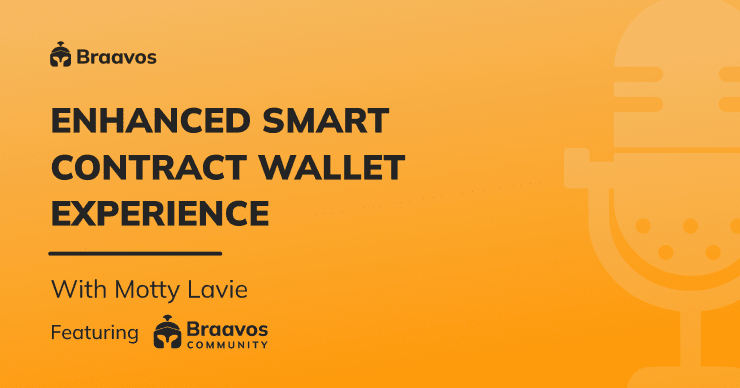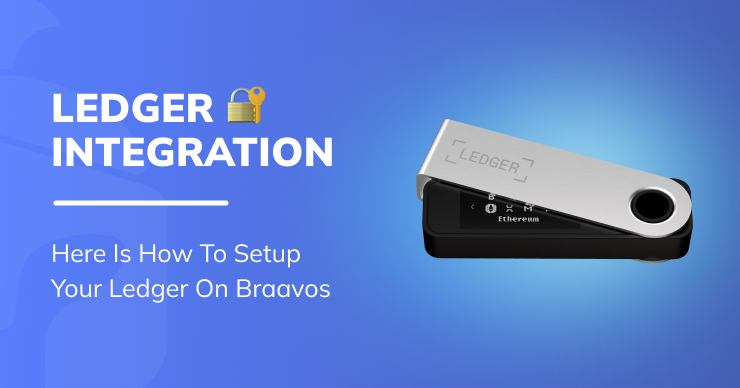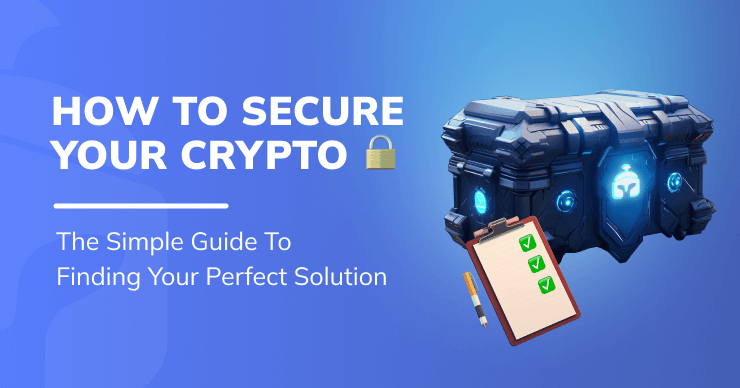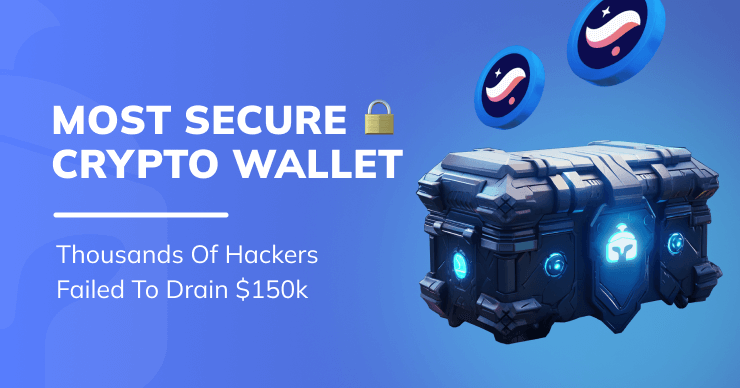Enhanced Smart Contract Wallet Experience With Braavos’ 3 Latest Features And StarkNet Update
Elevating Smart Contract Wallets With 3 Latest Features And StarkNet 0.11 Advancements

For this new episode of #Braavosianstalk, our hosts Motty Lavie, Braavos’ Founder & CEO, and Bertrand Blancheton, Head of Marketing, discuss the three new features in Braavos version 3.9.2 and the development of the StarkNet network.
Questions overview
- Why is the StarkNet version 0.11 update significant?
- Will we see gas costs lower than $1 or even 10 cents per transaction on the StarkNet network?
- Can you tell us about the Hardware Signer’s update?
- What happens if I have the Hardware Signer enabled and I swap some crypto using my computer?
- Can you tell us more about the synchronization of transaction history?
- What’s the dApp Gallery and why is it important?
- Do you have any plans to support other blockchains?
Let’s start with the latest update from StarkNet. They have shared a lot of information about version 0.11 of their testnet. Why is this update significant?
There are two major milestones that are important for us. Firstly, the upgrade of the Cairo programming language to version 1.0. This will allow us to create more expressive contracts and enable the StarkNet network to prove not only regular transactions but also rejected transactions.
This is a crucial element that will help move the StarkNet network from Alpha to Beta. The sequencer will be able to charge a gas fee for rejected transactions, which means that no one will be able to DDoS the network, similar to what happens on the Ethereum base chain. DDoS attacks occur when someone tries to attack the network by sending a lot of false transactions that use network resources without paying for them. This is obviously not advantageous for regular users.
The second significant development is that at Braavos, we are working with the StarkWare team to compress Cairo steps, which are the computations done on the network, in order to get gas prices that match more closely the real cost of a transaction after it has been proven from StarkNet to Ethereum L1.
In essence, this means that we will have much cheaper transactions, particularly for transactions that involve computation. This is important for features such as the Hardware Signer and the Multi-Signer, which will now have a gas cost per transaction that is nearly 10 times cheaper. This will make the difference in gas price between a regular STARK transaction and a transaction signed by the Hardware Signer negligible.
Let’s talk about gas cost, it’s really interesting. Recently, I was using Metamask to do some transactions on Ethereum and I noticed two things. First, the gas price for swapping tokens was between $9 and $16. Second, the wallet itself was charging a fee for the transaction. When we compare this to StarkNet, the price is only about $1.30 to $1.60, almost 10 times less than Ethereum, and with the Braavos wallet, there are no operation fees.
You mentioned that the gas cost could eventually be 10 times lower than it is now, with a potential cost of around 16 cents per transaction.
Will we see gas costs lower than $1 or even 10 cents per transaction on the StarkNet network?
The answer is a bit complex. With StarkNet version 0.11, we will see much cheaper transactions. However, it’s important to understand that the gas fee charged by the network is made up of several elements:
• Computation elements, the number of steps that need to be completed for the transaction to go through.
• Storage elements, which are the changes added to the blockchain that are saved for eternity.
• And also some other elements like messages, et cetera.
Version 0.11 will significantly optimize the computation element, which will reduce the cost for transactions that require a lot of computation, such as those involving the Hardware Signer and the Multi-Signer
In the future, there is a plan called Volition that will reduce the price of storage. Additionally, in version 0.12, we will see a more than tenfold improvement in transactions per second (TPS). This means each block will have more transactions, reducing the cost of each individual transaction.
Combining these improvements should result in a significant reduction in gas costs. While it’s unclear exactly how cheap gas will get on version 0.12, StarkNet’s official goal is to have transactions cost only cents, not 16 cents, but single-digit cents. Version 0.11 and 0.12 will be major steps toward that goal, and future versions will bring us even closer to single-digit cents per transaction.
I know that the tech team has been working hard on three new features, one of which was well-awaited by the community.
Can you tell us about the Hardware Signer and its evolution?
We received feedback from many users in the community who mentioned that once they enabled the Hardware Signer or the Protected Signer on their mobile devices (be it iPhone or Android), they were unable to interact with the extension on their computers. The reason behind this is that when the Hardware Signer is enabled, we want only the secure chip on the mobile device to be able to sign transactions. Naturally, the secure chip resides on the mobile device, not the computer, which means that the computer cannot sign transactions once the Hardware Signer is enabled. However, the community expressed their concerns about feeling limited and finding it less convenient to interact with dApps, especially since many dApps on StarkNet have yet to adapt for mobile use.
In this release, you are now able to interact with all the dApps on your extension, even if you have the Hardware Signer or the Protected Signer enabled on your mobile device. You can create a transaction, and the dApp will communicate with the browser extension. When you’re ready to sign the transaction, you can open Braavos on your mobile device and sign the transaction there. This way, you get the best of both worlds: the convenience and comfort of the larger computer screen, along with the added security provided by the mobile security chip.
Let’s discuss how this improvement works.
Let’s say you have the Hardware Signer enabled and you swap some crypto using your computer. What happens in this scenario?
If you have enabled notifications on your mobile device, you will receive a notification indicating that a transaction is awaiting your approval. Simply open the Braavos mobile app, where you will find the sign transaction screen. Review the transaction details to see what the dApp requires you to sign, and then authenticate yourself using your biometric ID, either face ID or fingerprint. Once authenticated, the transaction will be signed and sent to the blockchain.
If you haven’t enabled notifications on your mobile device, just open the Braavos app. It will automatically detect that a transaction is pending your approval and present the ‘sign transaction’ screen. Review the transaction details, and if you wish to proceed, sign and approve it using your biometric ID. The transaction will then be signed and sent to the network.
This process is very similar to the familiar two-factor authentication used in traditional web2 applications. You interact with the computer and simply open the mobile app to confirm the transaction.
The second feature that was included in this update is the synchronization of transaction history, correct?
Yes, exactly. This feature also comes from community feedback.
The Braavos applications operate in a stateless manner, which means they don’t rely on a central server to synchronize data. Instead, they solely rely on the blockchain as the source of information. Before this update, when users recovered their wallet on a new device, they didn’t see their transaction history from the old device. Also, if the user had both the extension on his computer and the mobile application, and he performed a transaction on one device, he wouldn’t see the transaction on the other device’s history. This transaction synchronization feature solves both of these issues.
When you recover your account on a new device, you are now able to view the complete transaction history associated with that account. Furthermore, if you perform a transaction on your mobile device, for instance, you will now see that transaction appear in the activity list on your extension.
The third feature that will be introduced in the upcoming update is called the dApp Gallery.
Could you explain what is the dApp Gallery and why it’s important for us?
That’s another feature that we are very excited about, and that’s another feature that came from the community.
We noticed that many Braavos users want to try as many StarkNet protocols and dApps as possible. To assist them in doing so, we have created a dedicated section within the wallet where you can discover all the live dApps on both mainnet and testnet. You will be able to see which dApps you have interacted with, the number of interactions you’ve had, and which dApps you haven’t yet explored. Additionally, any new dApps will be easily visible in this section. This functionality will make it much simpler for users to keep track of all the new protocols on StarkNet and their own interactions on the network.
This will be very useful for users and we are very excited about that. We look forward to getting feedback from the community.
Do you have any plans to support other blockchains?
Because as we all know, there are a lot of blockchains nowadays, and it would be very convenient to enjoy Braavos’ features on other blockchains, not just StarkNet.
Indeed, this is something we are actively considering. However, for us, it’s not only about supporting various chains but also about what each chain can enable us to offer and the kind of features we can provide to our users. StarkNet, for instance, allows us to implement features such as the Hardware Signer, Multi Signer, and the upcoming Paymaster. Additionally, we aim to achieve very low transaction fees, as discussed earlier, in the range of single-digit cents.
Currently, there are limited options in terms of chains that can support these requirements. Nevertheless, we are thoroughly exploring available possibilities and assessing the viability of each. In the future, I believe there will be other chains, besides StarkNet, that align with our vision and possess the capabilities to execute and support the features we require. We will consider expanding to those networks as well.
To join the Braavos Nation and share your feedback, we encourage you to connect to our Discord, and Twitter to get in touch and catch the latest news.
You can also benefit from the Hardware Signer by downloading the Braavos smart contract wallet on mobile for Android and iOS, and on multiple browsers: Chrome, Firefox, and more.




